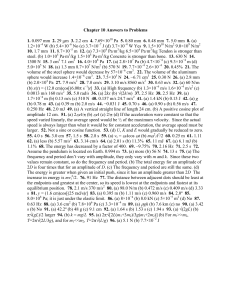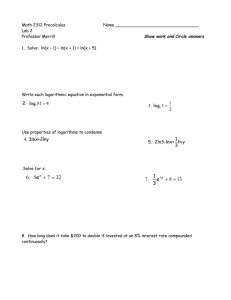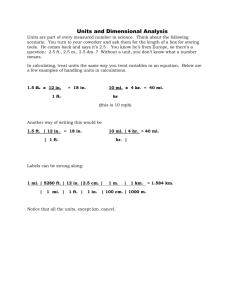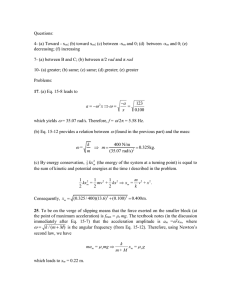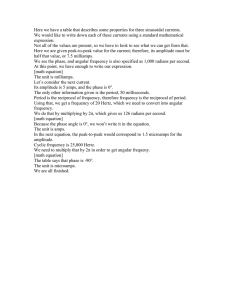Notes on Measuring Frequency Response
advertisement
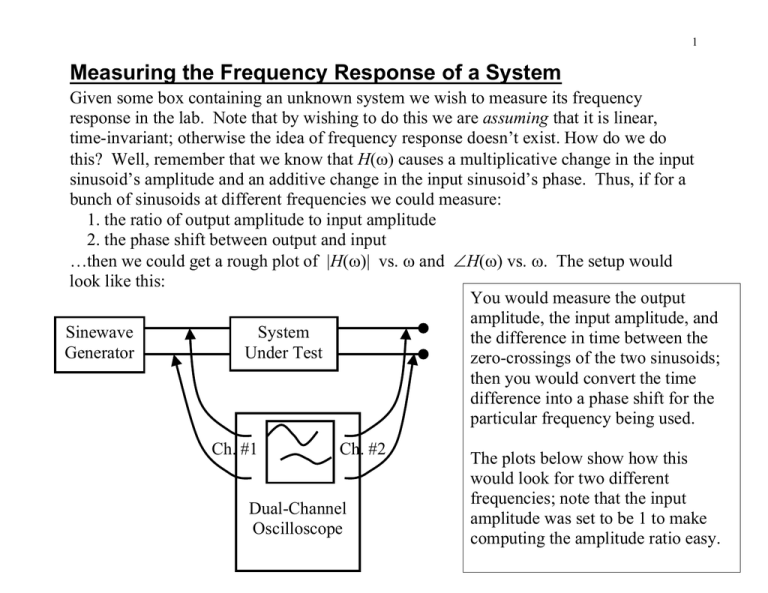
1 Measuring the Frequency Response of a System Given some box containing an unknown system we wish to measure its frequency response in the lab. Note that by wishing to do this we are assuming that it is linear, time-invariant; otherwise the idea of frequency response doesn’t exist. How do we do this? Well, remember that we know that H(ω) causes a multiplicative change in the input sinusoid’s amplitude and an additive change in the input sinusoid’s phase. Thus, if for a bunch of sinusoids at different frequencies we could measure: 1. the ratio of output amplitude to input amplitude 2. the phase shift between output and input …then we could get a rough plot of |H(ω)| vs. ω and ∠H(ω) vs. ω. The setup would look like this: You would measure the output amplitude, the input amplitude, and Sinewave System the difference in time between the Generator Under Test zero-crossings of the two sinusoids; then you would convert the time difference into a phase shift for the particular frequency being used. Ch. #1 Ch. #2 Dual-Channel Oscilloscope The plots below show how this would look for two different frequencies; note that the input amplitude was set to be 1 to make computing the amplitude ratio easy. 2 Input = 1.0 Input & Output at ω = 200 π rad/s ec 1 0.8 Output = 0.45 0.6 S ignal V alue (volts) 0.4 0.2 0 -0.2 -0.4 -0.6 -0.8 -1 0 0.005 0.01 0.015 ∆t = 0.00175 sec 0.02 0.025 0.03 Tim e (sec onds ) 0.035 0.04 0.045 0.05 ∆φ = ω∆t =(200π)(0.00175) = 0.35π radians Because the output LAGS the input, the angle becomes negative: – 0.35π radians 3 Input = 1.0 Input & Output at ω = 1000 π rad/s ec 1 0.8 0.6 Output = 0.1 S ignal V alue (volts ) 0.4 0.2 0 -0.2 -0.4 -0.6 -0.8 -1 0 0.001 0.002 0.003 0.004 0.005 0.006 0.007 0.008 Tim e (s ec onds ) ∆t = 0.00047 sec 0.009 0.01 ∆φ = ω∆t =(1000π)(0.00047) = 0.47π radians Because the output LAGS the input, the angle becomes negative: – 0.47π radians 4 The following table would result if you performed the above procedure at each of the frequencies listed in the table; the two highlighted rows are for the two cases shown above. ω |H(ω)| (rad/sec) 0 1.00 628 0.45 1257 0.24 1885 0.16 2513 0.12 3142 0.10 6283 0.05 9425 0.03 12566 0.03 15708 0.02 18850 0.02 21991 0.01 25133 0.01 28274 0.01 31416 0.01 ∠H(ω) (radians) 0 -0.35π -0.42π -0.45π -0.46π -0.47π -0.48π -0.49π -0.49π -0.49π -0.49π -0.50π -0.50π -0.50π -0.50π If you plot these results and fill in between the plotted points with a smooth curve you get the plots shown below for the frequency response of the system. This plot gives an experimental characterization of the system’s frequency response. You could use this to try to find an equation for H(ω) that would closely fit these experimental curves. You could then use that result for further analysis & design. 5 M agnitude of Frequenc y Res ponse 1 |H(ω )| 0.8 0.6 0.4 0.2 0 0 0.5 1 1.5 2 Frequenc y , ω (rad/s ec ) 2.5 3 3.5 x 10 4 P has e of Frequenc y Respons e 0 [< H(ω )]/ π -0.1 -0.2 -0.3 -0.4 -0.5 0 0.5 1 1.5 2 Frequenc y , ω (rad/s ec ) 2.5 3 3.5 x 10 4
